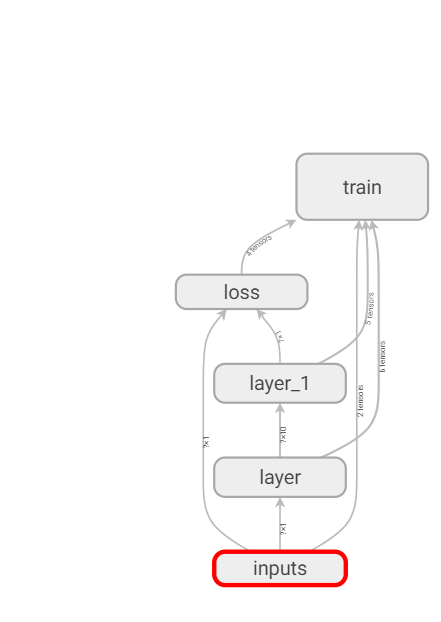先上代码:
#这个是tensorboard可视化的一个例子,没有训练数据那部分,不过对于讲解如何进行tensorboard的可视化已经够了 from __future__ import print_function import tensorflow as tf def add_layer(inputs, in_size, out_size, activation_function=None): # add one more layer and return the output of this layer with tf.name_scope('layer'): with tf.name_scope('weights'): Weights = tf.Variable(tf.random_normal([in_size, out_size]), name='W') with tf.name_scope('biases'): biases = tf.Variable(tf.zeros([1, out_size]) + 0.1, name='b') with tf.name_scope('Wx_plus_b'): Wx_plus_b = tf.add(tf.matmul(inputs, Weights), biases) if activation_function is None: outputs = Wx_plus_b else: outputs = activation_function(Wx_plus_b, ) return outputs # define placeholder for inputs to network with tf.name_scope('inputs'): xs = tf.placeholder(tf.float32, [None, 1], name='x_input') ys = tf.placeholder(tf.float32, [None, 1], name='y_input') # add hidden layer l1 = add_layer(xs, 1, 10, activation_function=tf.nn.relu) # add output layer prediction = add_layer(l1, 10, 1, activation_function=None) # the error between prediciton and real data with tf.name_scope('loss'): loss = tf.reduce_mean(tf.reduce_sum(tf.square(ys - prediction), reduction_indices=[1])) with tf.name_scope('train'): train_step = tf.train.GradientDescentOptimizer(0.1).minimize(loss) sess = tf.Session() # tf.train.SummaryWriter soon be deprecated, use following if int((tf.__version__).split('.')[1]) < 12 and int((tf.__version__).split('.')[0]) < 1: # tensorflow version < 0.12 writer = tf.train.SummaryWriter('logs/', sess.graph) #把session写进文件中,然后就可以在浏览器查看了 else: # tensorflow version >= 0.12 writer = tf.summary.FileWriter("logs/", sess.graph) # tf.initialize_all_variables() no long valid from # 2017-03-02 if using tensorflow >= 0.12 if int((tf.__version__).split('.')[1]) < 12 and int((tf.__version__).split('.')[0]) < 1: init = tf.initialize_all_variables() else: init = tf.global_variables_initializer() sess.run(init) print('done') # direct to the local dir and run this in terminal: # $ tensorboard --logdir=logs
我的文件生成在D:\machineLearning\my_tensorflow\tensorboard\logs文件夹下。在浏览器查看步骤如下:
1 打开cmd,定位到D:\machineLearning\my_tensorflow\tensorboard文件夹
2 敲入命令:
tensorboard --logdir=logs
3 到链接 http://DESKTOP-2C6NL8L:6006 查看,这个链接可在第2步的命令运行后得到,根据输出结果得到。
4 用谷歌浏览器(tensorflow是谷歌的亲儿子,其它浏览器可能不兼容,不一定能查看)查看,结果如下:

